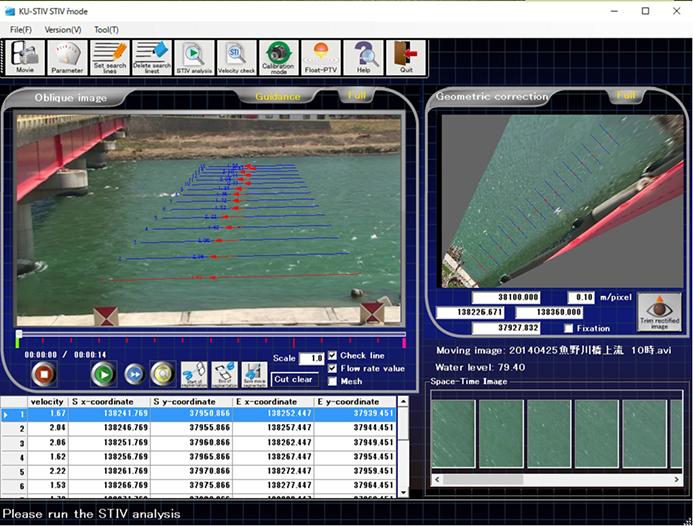Measuring river surface flow with image analysis

A screenshot of the English-language version of the KU-STIV system, used to measure river flow rate. Credit: Kobe University
Japan is hit by flood-related disasters almost every year – one of the most recent examples occurred in September 2015 when the Kinugawa River collapsed its banks, sending a wall of water into the nearby town of Joso. Accurate data for rainfall and river flow rate are vital elements in creating flood risk management strategies.
Thanks to developments in radar technology, rainfall measurements have become highly precise. However, measuring the flow rate of rivers is still carried out using the old-fashioned method of dropping a stick-shaped float in the river and estimating the flow rate from the float's speed through a section of the river.
When extreme flooding occurs this method becomes difficult to conduct due to the dangers involved, and there are a growing number of cases in which flow rates cannot be measured at the peak of a flood.
The KU-STIV system developed by Professor Fujita uses video footage taken from cameras and drones to measure the river flow rate. The system superimposes “searching lines” (each between 10 and 20 meters long) on footage of the river as measurement standards.
It calculates the flow speed from the time it takes water surface features and floating matter on the surface of the river to cross these lines, then analyses distribution to indirectly calculate the river flow rate.
Surface flow measurements taken using this system were very similar to those taken using acoustic current meters (ADCPs) and it can be used to measure river flow rates faster and more safely than the established method.
KU-STIV has already been adopted by many river consultants and River Offices in Japan's Ministry of Land, Infrastructure, Transport and Tourism, and organizations in Hyogo Prefecture have begun adapting the system for river observation cameras.
An English-language version of the system is also available, and recently Ghana researchers invited by the Japan International Cooperation Agency (JICA) are being trained to use the technology.
“We are aiming to adapt this system for real-time calculations, and at the same time we want to establish this as the standard method for measuring river flow rate both within Japan and overseas” commented Professor Fujita.
Media Contact
All latest news from the category: Earth Sciences
Earth Sciences (also referred to as Geosciences), which deals with basic issues surrounding our planet, plays a vital role in the area of energy and raw materials supply.
Earth Sciences comprises subjects such as geology, geography, geological informatics, paleontology, mineralogy, petrography, crystallography, geophysics, geodesy, glaciology, cartography, photogrammetry, meteorology and seismology, early-warning systems, earthquake research and polar research.
Newest articles

Webb captures top of iconic horsehead nebula in unprecedented detail
NASA’s James Webb Space Telescope has captured the sharpest infrared images to date of a zoomed-in portion of one of the most distinctive objects in our skies, the Horsehead Nebula….

Cost-effective, high-capacity, and cyclable lithium-ion battery cathodes
Charge-recharge cycling of lithium-superrich iron oxide, a cost-effective and high-capacity cathode for new-generation lithium-ion batteries, can be greatly improved by doping with readily available mineral elements. The energy capacity and…

Novel genetic plant regeneration approach
…without the application of phytohormones. Researchers develop a novel plant regeneration approach by modulating the expression of genes that control plant cell differentiation. For ages now, plants have been the…





















